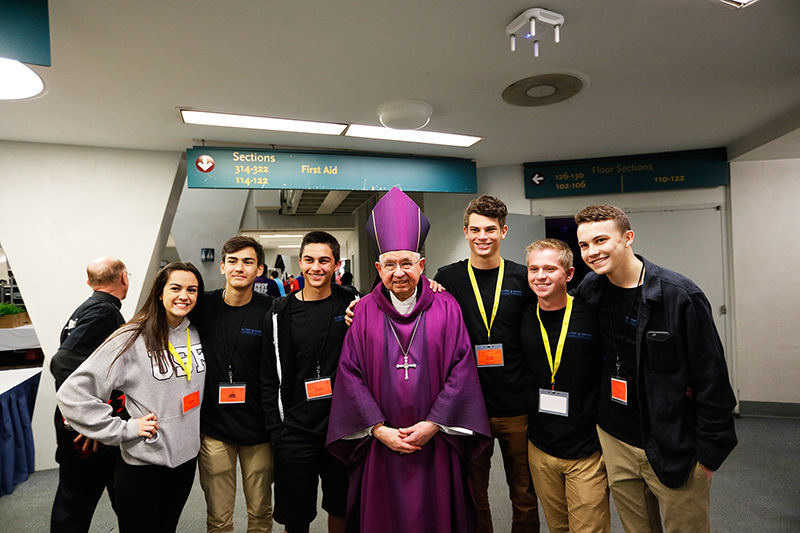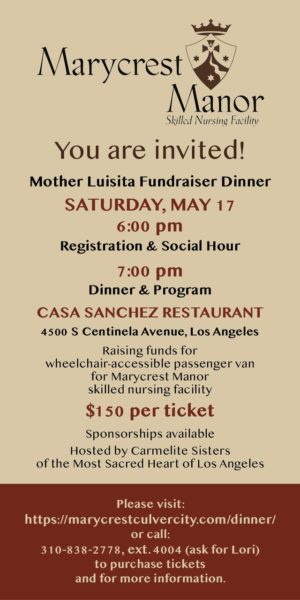The Super Bowl wasn’t yet called the Super Bowl when it was first played on Sunday, January 15, 1967 at the Los Angeles Memorial Coliseum. It was, rather, the “AFL-NFL World Championship Game” between the Green Bay Packers and Kansas City Chiefs.
And the Religious Education Congress wasn’t yet called the Religious Education Congress when it opened two days ahead of the football game — on Friday, Jan. 13, 1967, 18 miles to the west of the Coliseum at the International Hotel near Los Angeles International Airport. It was the “Southern California Confraternity Congress,” without Packers and Chiefs, but with plenty of catechists and speakers.
In fact, there were over 7,000 attendees at the three-day Congress — more than double the anticipated 3,000 — and zero empty seats, in contrast to the more than 35,000 empty seats at the 100,000-seat Coliseum.
And the desire and demand for quality education and formation, the sharing of ideas and — not the least important, by any means — encounter, fellowship and support from fellow Catholics has only grown in the five decades since then.
Today, the Los Angeles Religious Education Congress has become the largest gathering of its kind in the world. More than 40,000 people — enough to more than fill the empty Coliseum seats of “Super Bowl I” — attend Congress, many from far beyond its Southern California home base.
The early days
But Congress’ roots can actually be traced to 1922, and the beginning of the Confraternity of Christian Doctrine ministry in the growing Diocese of Los Angeles-San Diego. Its initial purpose included teaching Mexican refugees who were fleeing their country’s revolution and persecution of religious institutions.
So successful was this effort that other dioceses in the U.S. and Latin America followed suit. A year after the establishment of the Los Angeles Archdiocese in 1936, Archbishop John Cantwell established the CCD Office with Msgr. John Clarke as director, a post he held for 33 years, through rapid post-war growth in Southern California that saw a surge in the number of parishes and Catholic schools.
In 1956, what we know today as the “Religious Ed Congress” first took shape as the “Confraternity of Christian Doctrine Institute” held at Mount Carmel High School on Hoover Street near downtown Los Angeles. Organized under the leadership of Msgr. Clarke and Father (later Msgr.) Leland Boyer, the two-day conference drew 500 teachers and catechists, who listened to speakers and interacted with their peers.
Over the next decade, the Institute continued to grow, exacerbated by the Second Vatican Council and its flood of changes affecting numerous areas of Catholic life — and the need and desire to be better acquainted with and informed of those changes. The Institute moved to be better acquainted with and informed of those changes. The Institute moved to Bishop Conaty Catholic Girls High School, Loyola University and Immaculate Heart College in 1966, where attendance of more than 4,000 convinced archdiocesan leaders that a larger venue was essential.
Desire for knowledge
The inaugural Southern California Confraternity Congress in early 1967 was a cooperative planning effort by the entire Los Angeles Province (which then included the Archdiocese of Los Angeles and Dioceses of San Diego and Monterey-Fresno). The Congress, said officials, was designed “to provide an atmosphere of Christian unity ... for the benefit of each and the common good of all mankind.”
With the Second Vatican Council having concluded 13 months earlier, this was a time of change in the Catholic Church, though many were still processing those changes (“processing,” admittedly, was not a word generally used in the mid-1960s), and assessing how best to implement them.
And if some leaders in the archdiocese wondered whether interest in learning about these changes, or in learning how to better instruct Catholic youth and adults in the faith, was substantial, the 7,000 who overflowed the Intercontinental Hotel that weekend answered their questions.
Participants would, of course, have preferred more space. Lengthy elevator waits were commonplace, and workshops quickly ran out of seats, with catechists standing in the halls to gain as much knowledge as possible.
Certainly, the flood of Congress attendees — who paid all of $5 apiece to register — indicated that the desire for knowledge was growing at least as fast as the Southland’s Catholic community itself.
And after two more packed years in Los Angeles — as the Confraternity Congress in 1968, and the CCD Congress in 1969 — it was clear a new, larger venue was in order.
A new home
Having received a new leader in 1970 in Archbishop Timothy Manning (a longtime L.A. auxiliary before being named the first bishop of the new Fresno Diocese in 1967), the L.A. Archdiocese still included Orange County, where there was (a) a convention center, like Los Angeles, but with (b) lots of nearby (and affordable) hotels, motels and even parking, unlike Los Angeles.
The decision was made, amid some trepidation, to move the renamed Confraternity of Catholic Doctrine Congress to the Anaheim Convention Center. Like 1967, any fears that not enough people would attend were quickly dispelled, with more than 10,000 attending workshops and liturgies. Adjoining hotel ballrooms and meeting rooms hosted workshops (as they do today), and the closing Sunday Mass in the 8,000-seat arena became one of the largest annual worship gatherings in the West.
The CCD Congress of Feb. 20-22, 1970, also was the first to adopt a theme: “That All May Be One.” Subsequent Congresses have drawn their themes from the Scriptures of Congress Sunday, with the first bilingual theme included in the logo of the 1979 Congress: “He Calls Us Each By Name”/ “Nos Llama Por Nuestro Nombre.”
Other milestones rapidly followed. The first Congress “Youth Rally” for high school-aged Catholic youth took place at the 1971 event, setting the stage for “Youth Day” that now draws upward of 15,000 on Thursday of Congress Week, and sells out well in advance.
In 1973, the event was renamed “Religious Education Congress,” coinciding with the renaming of the CCD Office as the Office of Religious Education, and the appointment of Msgr. John Barry as director of the office, who continued to stretch the office’s (and, by extension, Congress’) scope to reflect the unequalled diversity of Southern California’s Catholic community.
Notably, 1973 also saw the first Congress workshops offered in Spanish. Since then, workshops have been presented in many other languages (including Vietnamese) and for hearing-impaired.
The workshops themselves have long since stretched beyond catechetical/educational subject matter to embrace liturgy, family life, social justice and subjects that draw participants from all areas of ministry, adding to the richness of the weekend.
Continued growth
Also reflecting Southern California’s Catholic diversity are the multiple liturgies celebrated during Congress weekend, not only in different languages but with an eye to different styles of expression and worship — jazz, gospel, contemplative, Taize, traditional and contemporary — giving rise to Congress’ reputation as enabling and reflecting the most comprehensive liturgical expression of Catholic faith anywhere, most notably in the closing liturgies in the arena on Congress Sunday.
Much of that growth took place under the leadership of Msgr. Lloyd Torgerson, who led the Religious Ed Office from 1983 to 1987 and appointed two women to leadership roles: Religious Sister of Charity Edith Prendergast, as the office’s first female associate director, and Adrian Whitaker, as fulltime Congress coordinator. The appointments reflected then-new Archbishop Roger Mahony’s efforts to increase the presence of women in diocesan leadership.
Sister Edith — who was still a few years from entering her community novitiate in Ireland when the first institutes were held in the 1950s — led the Congress’ continued growth in the 1990s as it became a nationally- and internationally-recognized event, drawing attendees from around the world as well as the U.S.
Speakers, too, were from an increasingly wide array of localities and perspectives. Clergy of different faiths, lay leaders of different backgrounds, authors and actors — all of them sharing (and gaining) insights with their predominantly (but not exclusively) Catholic audience.
New, familiar and evolving
This year’s “Congress 50” ushered in a new era, with Father Chris Bazyouros having succeeded Sister Edith as ORE director. But many familiar faces returned — among them Paulette Smith and Jan Pedroza, in their ninth years as Congress co-coordinators, and John Flaherty, in his 25th year as Congress music director.
The format of Congress has largely remained the same over the years, with some tweaking. It is still held most often in February or March, and most often during Lent (like this year).
Three 90-minute workshop periods are held on Friday and Saturday and two on Sunday. In 1998, the “ninth period” (or third Sunday workshop) was replaced by a Sunday morning keynote, allowing the closing liturgy to begin at 3:30 p.m. (instead of 5:15 p.m.) and enabling attendees a chance to get home earlier.
The convention center itself has been expanded and remodeled from what it was in 1970, when the Los Angeles Stars of the American Basketball Association called the arena home. And more large hotels now surround the facility, though it is still possible (and for many attendees, preferable) to walk several blocks from lower-cost hotels in the area.
For much of its history, Congress offered “workshops on tape,” with cassette recordings available for those who couldn’t attend everything they wanted to. And technology continues to make Congress’ offerings more accessible, especially the explosion in social media. Livestreaming has allowed more people — many of them “logging on” from around the world — to experience Congress.
Which suggests, quite conclusively, that while football games (and teams, for that matter) may come and go, Catholics’ desire and passion for learning about and growing in faith are still very much present — and, at Congress, quite available.
Sources for this article include contributions by Msgr. Francis Weber, Sister of Notre Dame Joanne Wittenburg, Hermine Lees and the Office of Religious Education.

